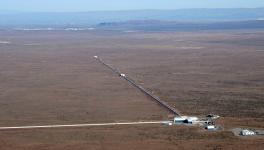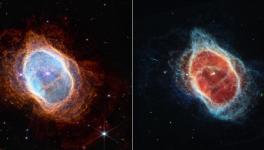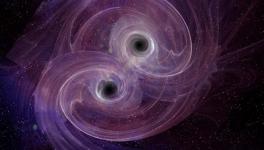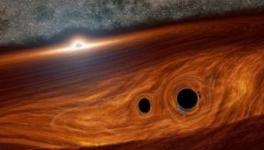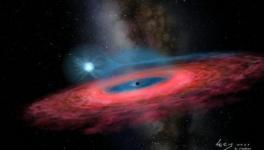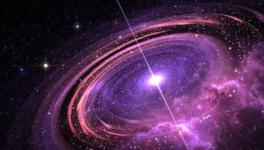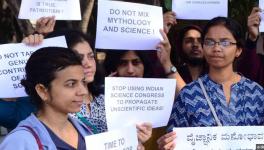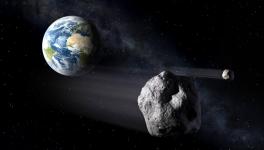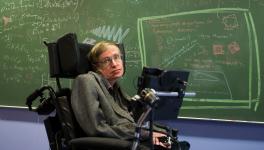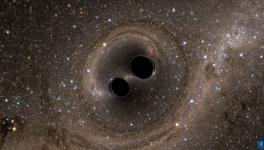Detection of Gravitational Waves
Albert Einstein predicted the existence of gravitational waves in 1916 in his general theory of relativity. According to the master, space and time are aspects of a single measurable reality called space-time. It was not discovered till the LIGO, a large-scale physics experiment and observatory lab in United States has detected its existence. This discovery has been claimed as a breakthrough discovery in Astrophysics after a century of expectations.
D.Raghunandan discussed this subject with Professor Patrick Dasgupta, from Physics & Astrophysics Department, Delhi University. Professor Dasgupta explained what gravitational waves are, how it has been detected, the sophisticated techniques used and the people contributed to the findings. He also talked about black holes and how significant roles were played by Indian scientists in the field of astrophysics.
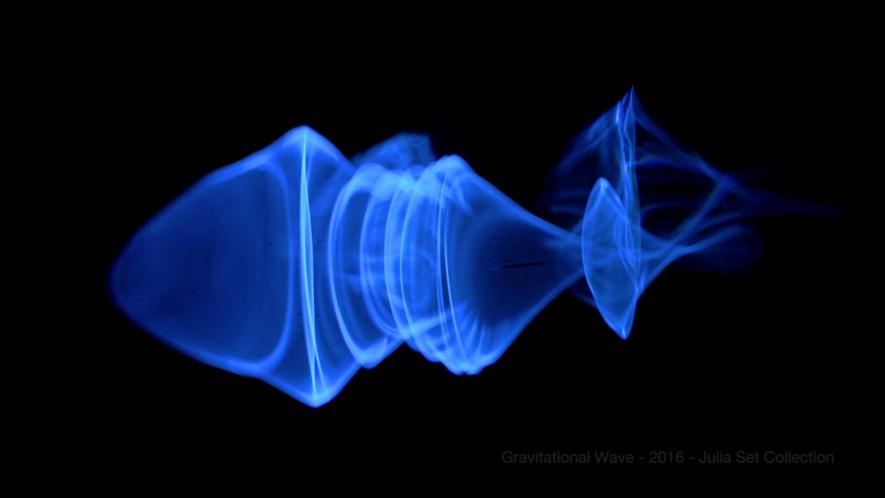
Image Courtesy: Youtube
Rough Transcript:
D. Raghunandan (DR): Hello and welcome to Newsclick. Just last week the world encountered one of those seminal moments which fundamentally changed the way we understand the universe and pursue further knowledge of it. High tech labs in the US assisted by scientists in many countries including India observed the first concrete evidence of gravitational waves which were predicted by Albert Einsteins more than 100 years ago. The proof of the existence of the gravitational waves not only opens up new waves of inquiry and ways of conducting it but also opens up the doors for a new kind of astronomy. To help us understand this discovery and it's implications, we have with us today Prof. Patrick Dasgupta of Delhi University, Department of Physics. Welcome Dr. Dasgupta. First let me begin you with asking you to explain for our viewers what are gravitational waves and why should we consider them so important?
Patrick Dasgupta (PD): Right, so Einsteins theory of relatively which he proposed about 100 years back in fact last year was the Einsteins centennial year of giving the general theory of relativity. Now, general theory of relativity is a theory of gravitation which is consistent with the theory of relativity. Now, special theory of relativity forbids any signal to move faster than the speed of light in vacuum and therefore, if you have gravity created by masses as given by the Newtonian laws of gravitation, then immediately one can ask if the masses changes their position would gravity be effected instantly. This was the problem of Newtonian gravitation and Einstein had realized that and he immediately saw that the special theory of relativity requires a modification of gravitation theory and in 1915 he gave the final formulation of general theory of relativity which is gravitation consistent with special theory of relativity. And therefore, immediately Einsteins theory would tell us that if you have mass distribution that are changing with time then in change in gravitation can not propagate faster than the speed of light. Sp they have to propagate then with the speed of light in vacuum and this propagating ripples of gravitation is what gravitation waves are.
DR: and for our purposes, if we go back a couple of hundred years or so, we are so used to thinking in terms of light waves motion by light, then electromagnetic waves and now we are thinking in terms of gravitational waves. So what difference does that make?
PD: Absolutely, you know that light which have been used to understand universe because we see the stars and make speculations about what stars are and then work of Maxwell showed light is nothing but change in electric and magnetic field, it's nothing but a special case of electromagnetic waves and then came radio waves and pioneering work was done by late Prof. Jagdish Chandra Bose whose work was applied by Marconi to essential make radio waves a communication tool and then at the beginning of 20th century, a revolution in astronomy came when radio astronomy was established, and radio astronomy showed there are many many objects emit radio waves which earlier was not predicted by optical astronomy. Things like quasars, things like blesars things like radio galaxies things like Pulsars they were all detected in radio waves.
DR: So how were the gravitational waves detected?
PD: Now, Einsteins theory came and said look just like electric charges move about changing the electric field that propogate as the electromagnetic waves similarly mass distribution when they change they would send gravitational waves that means changing gravitational field in space as well as time and therefore, everything has mass and momentum associated, every object in the universe have mass and energy and momentum and whenever they move about they will immediately send out gravitational waves. So by detecting this fluctuating gravitational field which we call gravitational waves we would be able to find out how different masses are changing with time, what are the masses. In fact, the gravitational waves was indirectly detected by Hulse and Taylor around 1974 when they discovered two very compact objects which are called neutron stars they discovered they are going about in about common centre of masswith a period of about 8 hours and immediately they realised neutron stars are massive objects and each of them were 1.4 times heavier than the sun and when they went around each other with a short period of 8 hours they must have released a lot of gravitational waves and if they are releasing gravitational waves, energy is being lost and therefore, they will be slowly in inspiralling because their energy is being dissipated in termes of gravitational waves and this inspiralling the period increasing the the semi major axis decreasing that was detected using radio waves by Hulse and Taylor and for that in 1993, Hutz and Taylor were awarded noble prize. But this was an indirect detection. One was not directly measuring gravitational wave rather one was inferring by the change in the period. Now the announcement which came on February 11 was that two LIGOS one in Louisiana and the other in Washington independently because we have to look for the evidence independently both detected the fluctuation in gravitation.
DR: Explain to us briefly this experimental set up and why it has taken us about 100 years to be able to prove what Einstein has foreseen and theoretically predicted but which we could not have observed till this experiment was set up and succeed.
PD: Absolutely. So gravitation is the weakest of all forces. For example, if I take two protons and ask what is the gravitational attraction compared to the electrostatic repulsion one will find easily that gravitation in 1040 weaker than electromagnetic force and therefore, whenever masses move about of course they produce gravitational waves, the amount of gravitational waves, it's strength is very very weak. For example, if a gravitational wave source emits out huge amount of gravitational wave acts a distance of 30,000 distance of light years from us. Then, the strain that it will cause because gravity is after all a geometrical effect. So the change in distance between any two test particles divided by the actual separation, the change in the distance divided by the actual separation will be will be less than a fraction of proton's diameter. We know proton's diameter is about 10-15 metres. So to measure the strain of a powerful supernova explosion creating gravitational explosion 30,000 light years away from us one has to measure the change in length between two objects kept 4 kms away is less than the diameter of the proton. That is mind boggling. So we require such a sensitivity. How on earth one is going to measure two mirrors which are kept at 4 kms away from each other and when a strong gravitational wave passes by the change in the length of a 4 km separated detector is only a fraction of a protons diameter. Therefore, the technique which is used is a cutting edge technique using quantum theory of light, using very fantastic seismic isolation using fantastic vacuum understanding using a very stable which will be able to emit a powerful amount of laser but at the stable thing, I mean the power must not fluctuate. So the Herculean task of detecting the length changes fraction of a proton's diameter made made so challenging that only after a 100 years of theoretical prediction, human beings could detect.
DR: Would you also agree that in a sense it shows once small how theoretical Physics is no longer possible to be pursued very effectively without the assistance of simultaneously of very advanced experimental science.
PD: Absolutely. See Physics, for that matter all of science they are experimental knowledge. After all science is all to find out how the nature works. And to find out how the nature works we just can't imagine. That will be mythology. So we have to model the workings of nature and in order to give the correct model, the best model we must constantly try to have a dialogue with nature. Dialogue with nature meaning we have to make experiment and see what nature tells us. So experiments are nothing but dialogue between scientists and the nature. Physics requires very good precisions experimental results. But sometimes, what happens that things like gravitation which are very weak forces experiments are not so easy. So therefore, theoretical people who using their mathematical genius using their idea of symmetries, aesthetics, they create model. Einstein who was the physicist who used the idea of aesthetics and Mathematics.
DR: But still at some point you require that experimental verification.
PD: Absolutely. In fact Einsteins general theory of relativity which was proposed in the final form in 1915 the first experimental that is bending of life was done in 1921. so he took long time, 6 years to test the first prediction.
DR: As part of experiment, there were teams of scientists from various parts of the world who participated in this not in direct measurement but in the calculations that went behind and so on. Could you tell our viewers something about role that Indian teams of scientists played in this.
PD: So Indian groups, particularly people who have produced from Raman research institute by Prof. Bala Iyer, what they did was they did very fine Mathematical calculations of when two mass points go about each other then what kind of gravitational wave signals they produce although to lowest orders the signal was known but Bala Iyer and his students they did higher order calculations to something called post Newtonian approximation to larger than 3.5 post Newtonian approximation they calculated the form of the signal which we call the chirp signal because they sounds like a chirp of a bird. On the other hand, they were doing theoretical calculations based on Einsteins general relativity but producing a Mathematical signal will tell you that these are kind of signals we expect but how do you pick it up from the experimental apparatus. We just said that the signals are very tiny. So the experimental signals are very noisy and you have in the noise a buried signal. So that has to be decoded. And the technique is also very well known RADAR uses the same technique. It is called match filtering technique.
DR: You have to basically filter out background noise.
PD: Yes. So if you know the correct form of signal which Bala's group were producing, the correct form of signal was known but the actual signal coming from the detector output is very noisy and your signal is buried in it, how to pull it out, so Sanjeev Dhurandar who was an erstwhile Professor of IUCAA in Pune, he and his students in Pune, students, post doctoral fellows, in fact, I was also a post doctoral fellow associated with him did similar kind of work. He led a full team finding out how do you analyse which the LIGO is giving us to pull out the signals. So his students, his post doctoral fellows established the ways of doing the match filtering so that you can pull out the signal.
DR: There is a proposal on the table for several years the proposal has been there to set up an experimental lab very similar to the one in the US in the India as well. Why India, what was the need to have another set up, is it do the distance between the one's with a proximity to the equator, could you tell us a little?
PD: It is a very important point. Now, how do you find when two detector have detected gravitational wave, how do you we find out the direction. So what one does is if there are two detector, the gravitational wave could be in any direction. So therefore, supposing one LIGO detector is here and other is here, this is near to the source , will first see the signal and after a delay, the other detector will see the signal. So what is the maximum delay possible. One had a detector on the North pole and another detector in the South pole that will be the maximum. The maximum delay would be about 40 milli seconds. It so happens that you have two LIGO detectors and if you have a detector in India then between the two LIGO and India the maximum delay possible is about 38 milli seconds which is very close to maximum. Therefore, India becomes a very prime country where one should set up a detector so that we can get a very big time delay from that we can find out which is the direction of the source. To find out the direction of the source accurately, we must have a detector in India.
DR: This is triangulation.
PD: Triangulation. Absolutely and this proposal has been there for about last 4 years. In fact, the LIGO people said that look we will despatch LIGO equipment to India, you install it, you find out how to make best use of it and this proposal was made by the Indian team. There is a whole Indigo consortium, many people, in fact, our Delhi University is also part of Indigo Consortium. I am also part of that.
DR: So how do the chances look for our …
PD: This proposal was lying with the cabinet for the last two years and estimated cost to install a LIGO India detector is about 1300 crores of Indian rupees. Due to some reason, the cabinet has been sitting on this proposal. We hope that soon it will be cleared particularly after the PM tweeted well, gravitational wave has been seen and India must have a detector.
DR: Is this also partly due to what has been a traditional shall we say fear in India or a hesitation to invest in basic research asking the question what are we going to get out of it, what's the practical spin off. So there has been this hesitation to invest. So is this part of that hesitation?
PD: Yes and no. After all India is a developing country and we must be very careful which direction we should be spending the money. That is one thing. But also I must also say that even physicist were not working on the gravitational wave. They are also little bit hesitant because it is a big amount of money and it is a very difficult experiment. So in the past, physicists were not associated with the gravity experiments. They have always been a little skeptical that should India go for such an experiment which is so difficult.
DR: Let me just ask you a last question. There was in the community of scientists considerable skepticism for considerable amount of times about gravitational wave, whether at all we would be able to prove it and what we were discussing now there were similar questions raised in the US as well. It took considerable time and courage for National Science Academy to approve this but finally they have detected it which has put some doubt at rest and given the fact that this signals emanated from twin black holes, has it also put at rest some of the similar skepticisms about black holes?
PD: Well, not really. The reason is the evidence which the February 11 announcement about two black holes slowly inspiralling and merging to create a massive 62 solar mass black hole, the evidence that they are black holes and not compact objects is still a little bit indirect because actually to have evidence of black hole one must hear the ringing of the black hole which is called the quasi normal mode gravitational wave emission when a black hole is formed. It is called ringing of the black hole. Incidentally, the first person to talk about the ringing of the black hole was a very reputed C.V. Vishveshwara. Now, he is retired, in Bangalore. But earlier, he was in Raman Research Institute, Bangalore. He was the first person in 1970 to do an experiment where when you disturb a black hole how does a black hole respond to the disturbance. So this quasi normal mode of research was started by Prof. Vishveshwara and in fact, the LIGO February 11 claim that they have seen two black holes merging in one bigger is that they have found that the ringing down has been almost, it is not clear whether one is really because the signal to noise ratio for the ringing down phase is slightly small. But no doubt with better and better advancement of LIGO detectors one will probably be able to pin point the ringing sound absolutely without any hesitant and doubt then, no one will ask any questions about the black holes.
DR: Thank you very much Partick for this very enlightening discussion and if you pardon the pun for throwing light on this important subject. Thank you.
PD: Thank you.
Get the latest reports & analysis with people's perspective on Protests, movements & deep analytical videos, discussions of the current affairs in your Telegram app. Subscribe to NewsClick's Telegram channel & get Real-Time updates on stories, as they get published on our website.









